
The Ring Nebula is a planetary nebula in the northern constellation of Lyra.[C] Such a nebula is formed when a star, during the last stages of its evolution before becoming a white dwarf, expels a vast luminous envelope of ionized gas into the surrounding interstellar space.

The Helix Nebula is a planetary nebula (PN) located in the constellation Aquarius. Discovered by Karl Ludwig Harding, most likely before 1824, this object is one of the closest of all the bright planetary nebulae to Earth. The distance, measured by the Gaia mission, is 655±13 light-years. It is similar in appearance to the Cat's Eye Nebula and the Ring Nebula, whose size, age, and physical characteristics are similar to the Dumbbell Nebula, varying only in its relative proximity and the appearance from the equatorial viewing angle. The Helix Nebula has sometimes been referred to as the "Eye of God" in pop culture, as well as the "Eye of Sauron".

The Cat's Eye Nebula is a planetary nebula in the northern constellation of Draco, discovered by William Herschel on February 15, 1786. It was the first planetary nebula whose spectrum was investigated by the English amateur astronomer William Huggins, demonstrating that planetary nebulae were gaseous and not stellar in nature. Structurally, the object has had high-resolution images by the Hubble Space Telescope revealing knots, jets, bubbles and complex arcs, being illuminated by the central hot planetary nebula nucleus (PNN). It is a well-studied object that has been observed from radio to X-ray wavelengths.
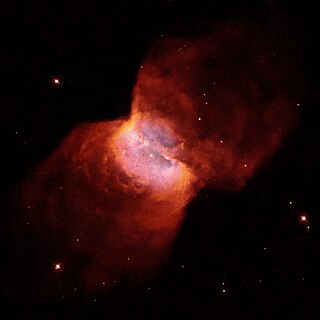
NGC 2346 is a planetary nebula near the celestial equator in the constellation of Monoceros, less than a degree to the ESE of Delta Monocerotis. It is informally known as the Butterfly Nebula. The nebula is bright and conspicuous with a visual magnitude of 9.6, and has been extensively studied. Among its most remarkable characteristics is its unusually cool central star, which is a spectroscopic binary, and its unusual shape.
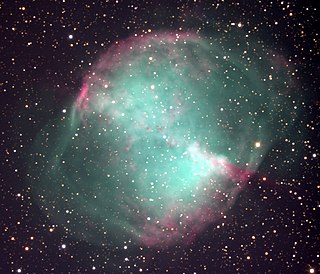
The Dumbbell Nebula is a planetary nebula in the constellation Vulpecula, at a distance of about 1360 light-years. It was the first such nebula to be discovered, by Charles Messier in 1764. At its brightness of visual magnitude 7.5 and diameter of about 8 arcminutes, it is easily visible in binoculars and is a popular observing target in amateur telescopes.
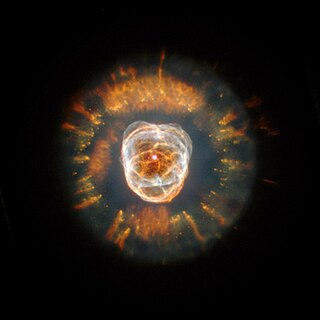
The Eskimo Nebula, also known as the Clown-faced Nebula, Lion Nebula, or Caldwell 39, is a bipolar double-shell planetary nebula (PN). It was discovered by astronomer William Herschel in 1787. The formation resembles a person's head surrounded by a parka hood. It is surrounded by gas that composed the outer layers of a Sun-like star. The visible inner filaments are ejected by a strong wind of particles from the central star. The outer disk contains unusual, light-year-long filaments.

The Saturn Nebula is a planetary nebula in the constellation Aquarius. It appears as a greenish-yellowish hue in a small amateur telescope. It was discovered by William Herschel on September 7, 1782, using a telescope of his own design in the garden at his home in Datchet, England, and was one of his earliest discoveries in his sky survey. The nebula was originally a low-mass star that ejected its layers into space, forming the nebula. The central star is now a bright white dwarf star of apparent magnitude 11.5. The Saturn Nebula gets its name from its superficial resemblance to the planet Saturn with its rings nearly edge-on to the observer. It was so named by Lord Rosse in the 1840s, when telescopes had improved to the point that its Saturn-like shape could be discerned. William Henry Smyth said that the Saturn Nebula was one of Struve's nine "Rare Celestial Objects".

The Little Dumbbell Nebula, also known as Messier 76, NGC 650/651, the Barbell Nebula, or the Cork Nebula, is a planetary nebula in the northern constellation of Perseus. It was discovered by Pierre Méchain in 1780 and included in Charles Messier's catalog of comet-like objects as number 76. It was first classified as a planetary nebula in 1918 by the astronomer Heber Doust Curtis. However, others might have previously recognized it as a planetary nebula; for example, William Huggins found its spectrum indicated it was a nebula ; and Isaac Roberts in 1891 suggested that M76 might be similar to the Ring Nebula (M57), as seen instead from the side view.

The Owl Nebula is a planetary nebula approximately 2,030 light years away in the constellation Ursa Major. Estimated to be about 8,000 years old, it is approximately circular in cross-section with a faint internal structure. It was formed from the outflow of material from the stellar wind of the central star as it evolved along the asymptotic giant branch. The nebula is arranged in three concentric shells, with the outermost shell being about 20–30% larger than the inner shell. The owl-like appearance of the nebula is the result of an inner shell that is not circularly symmetric, but instead forms a barrel-like structure aligned at an angle of 45° to the line of sight.
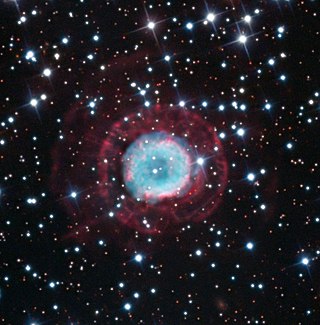
NGC 2438 is a planetary nebula in the southern constellation of Puppis. Parallax measurements by Gaia put the central star at a distance of roughly 1,370 light years. It was discovered by William Herschel on March 19, 1786. NGC 2438 appears to lie within the cluster M46, but it is most likely unrelated since it does not share the cluster's radial velocity.

NGC 7027, also known as the Jewel Bug Nebula or the Magic Carpet Nebula, is a very young and dense planetary nebula located around 3,000 light-years from Earth in the constellation Cygnus. Discovered in 1878 by Édouard Stephan using the 800 mm (31 in) reflector at Marseille Observatory, it is one of the smallest planetary nebulae and by far the most extensively studied.
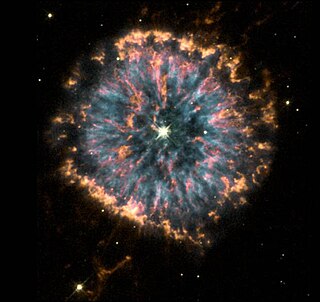
NGC 6751, also known as the Glowing Eye Nebula, is a planetary nebula in the constellation Aquila. It is estimated to be about 6,500 light-years away.
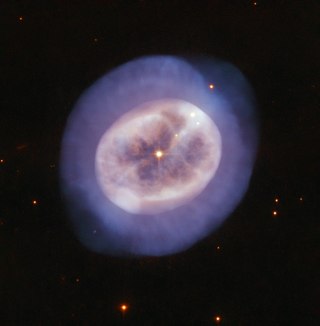
NGC 2022 is a planetary nebula in the equatorial constellation of Orion, located at a distance of 8.21 kilolight-years from the Sun. It was first observed by William Herschel on December 28, 1785, who described it as: considerably bright, nearly round, like a star with a large diameter, like an ill-defined planetary nebula. In medium-sized amateur telescopes it looks like a small grayish patch of light. It is not very bright but it is still easy to spot it in the eyepiece. Even in a telescope as small as 80mm it can just be seen using a narrowband filter such as an OIII filter as a 'fuzzy' star. The object has the shape of a prolate spheroid with a major to minor axis ratio of 1.2, an apparent size of 28″, and a halo extending out to 40″, which is about the angular diameter of Jupiter as seen from Earth.

NGC 3918 is a bright planetary nebula in the constellation Centaurus, nicknamed the "Blue Planetary" or "The Southerner". It is the brightest of the far southern planetary nebulae. This nebula was discovered by Sir John Herschel in March 1834 and is easily visible through small telescopes. The round or even slightly oval diameter is telescopically between 8 and 10 arcsec, though deep images extends this to about 19 or 20 arcsec. More surprising is the beautiful rich blue colour that looks much like the coloured images of Neptune taken by Voyager 2 in 1989.

NGC 5307 is a planetary nebula in the southern constellation of Centaurus, positioned less than 3° to the northeast of the star Epsilon Centauri. It was discovered by English astronomer John Herschel on April 15, 1836. The nebula is located at a distance of approximately 10.6 kilolight-years from the Sun. The central star, designated PNG 312.3+10.5, is a weak emission-line star, superficially similar to the WC subtype of Wolf–Rayet stars. It has a spectral class of O(H)3.5 V.

NGC 7354 is a planetary nebula located in the northern circumpolar constellation of Cepheus, at a distance of approximately 5.5 kly from the Sun. It was discovered by German-born astronomer William Herschel on November 3, 1787. John L. E. Dreyer described it as, "a planetary nebula, bright, small, round, pretty gradually a very little brighter middle".
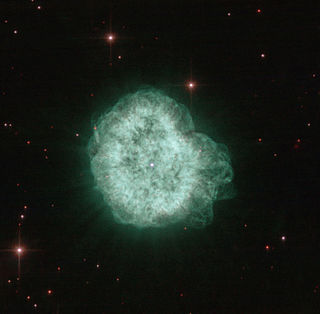
NGC 2867 is an elliptical Type II planetary nebula in the southern constellation of Carina, just over a degree to the NNW of the star Iota Carinae. It was discovered by John Herschel on April 1, 1834. Herschel initially thought he might have found a new planet, but on the following night he checked again and discovered it had not moved. The nebula is located at a distance of 7,270 light-years from the Sun.
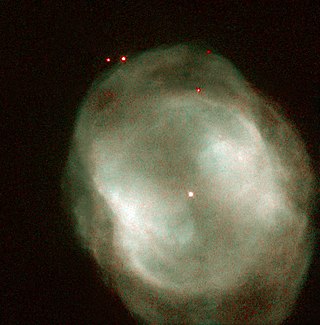
NGC 3195 is a planetary nebula located in the southern constellation of Chamaeleon. Discovered by Sir John Herschel in 1835, this 11.6 apparent magnitude planetary nebula is slightly oval in shape, with dimensions of 40×35 arc seconds, and can be seen visually in telescopic apertures of 10.5 centimetres (4.1 in) at low magnifications.
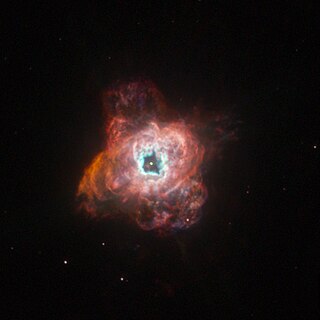
NGC 5315 is a planetary nebula in the southern constellation Circinus. Of apparent magnitude 9.8 around a central star of magnitude 14.2, it is located 5.2 degrees west-southwest of Alpha Circini. It is only visible as a disc at magnifications over 200-fold. The nebula was discovered by astronomer Ralph Copeland in 1883. The central star has a stellar class of WC4 and is hydrogen deficient with an effective temperature of 76-79 kK. The distance to this nebula is not known accurately, but is estimated to be around 6.5 kilolight-years.

NGC 6445, also known as the Little Gem Nebula or Box Nebula, is a planetary nebula in the constellation Sagittarius. It was discovered by William Herschel on May 28, 1786. The distance of NGC 6445 is estimated to be slightly more than 1,000 parsecs based on the parallax measured by Gaia, which was measured at 0.9740±0.3151 mas.




















